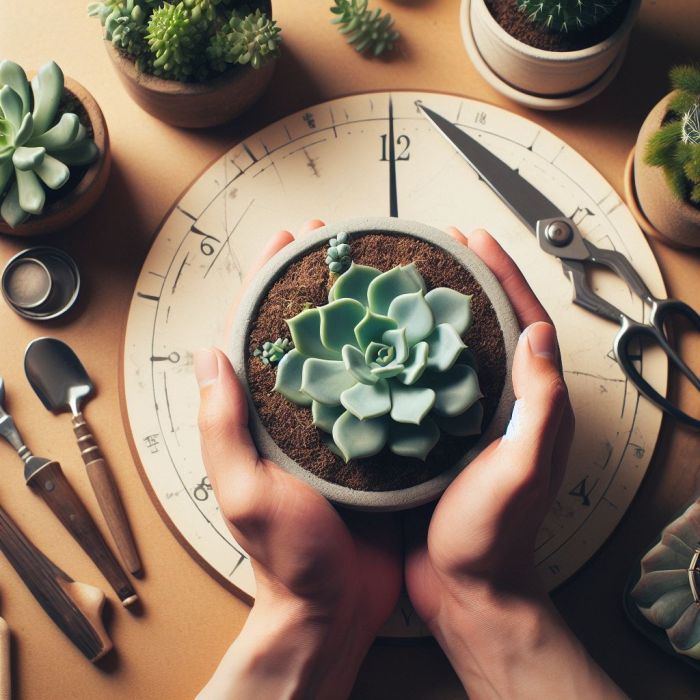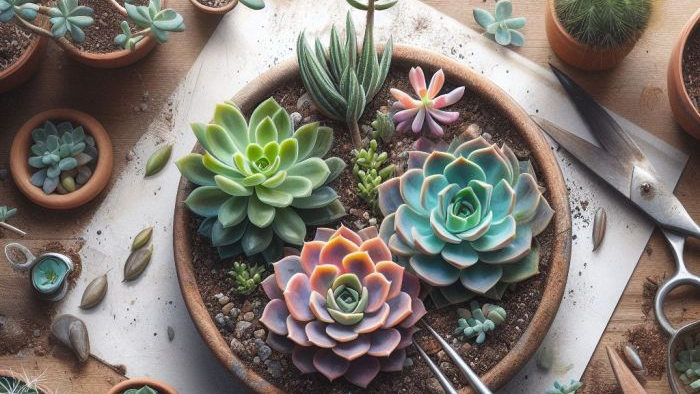Last updated on March 9th, 2024 at 06:27 am
Succulents aren’t just beautiful decorations; they’re also the go-to choice for new plant parents or those with busy lives. These desert plants thrive in sunlight and have thick leaves that hold water, meaning you can water them less often. If you’re hooked on these hardy plants and want more without breaking the bank, try propagating your own. This involves growing new plants from the leaves or stems of existing ones. It’s best to do this during the spring or summer when they get the most sunlight, which is crucial for their growth. However, if your area has favorable conditions, you can give it a go any time of the year!
Now, when it comes to repot succulent cuttings, it’s a simple yet vital task to ensure they thrive. Whether you’re expanding your collection or moving plants to larger pots, doing it properly can significantly impact their health. In this guide, we’ll take you through each step, making repotting your succulent cuttings a breeze.
Contents
- 1 What is repotting?
- 2 How to Repot Succulent Cuttings?
- 2.1 How to Repot Succulents from Stems
- 2.2 FAQs
- 2.2.1 What does “repot succulent cuttings” mean?
- 2.2.2 Why is repotting succulent cuttings important?
- 2.2.3 When is the best time to repot succulent cuttings?
- 2.2.4 How do I select the right succulent for propagating cuttings?
- 2.2.5 What precautions should I take when repotting succulent cuttings from leaves?
- 2.2.6 How do I repot succulents from stems?
- 2.2.7 Can I repot succulent cuttings into larger pots?
- 2.2.8 How long does it take for repotted succulent cuttings to establish roots?
- 2.2.9 Can I propagate succulent cuttings indoors?
- 2.3 Author
What is repotting?
Repotting is the process of transferring a plant from one pot to another, usually to provide it with more space for root growth, fresh soil, or a better environment for its development. It’s a common practice in plant care, often done when a plant outgrows its current pot or when its soil becomes depleted of nutrients. Repotting can help promote healthier growth, prevent overcrowding of roots, and rejuvenate the plant’s overall health and vitality.
How to Repot Succulent Cuttings?

Repot succulent cuttings from leaves are a fascinating and rewarding way to expand your succulent collection. This method mimics nature’s process, where succulents naturally produce new plants from dropped leaves. By following a few simple steps, you can harness the resilience and growth potential of succulents to create new plants from individual leaves. In this guide, we’ll explore the process of repotting succulent cuttings from leaves, or repot succulents cutting stems from selecting the right plant to caring for the new plantlets as they grow.
Selecting the Mother Plant:
- Choosing a Healthy Specimen:
For repot succulent cuttings look for a mature succulent with healthy, plump leaves and no signs of damage or disease.
- Identifying Suitable Species:
Certain succulents, such as jade plants, echeveria, and sempervivum rosettes, are particularly well-suited for leaf propagation due to their fleshy leaves and propensity to produce pups.
Taking the Cutting:
- Gentle Removal:
Carefully twist and pull a leaf from a mother plant, ensuring it is intact and undamaged.
- Optimal Leaf Condition:
Select a firm and healthy leaf, avoiding any shriveled, yellowed, or damaged, as these may have a lower chance of successful propagation.
Allowing the Cutting to Callous:
- Promoting Healing:
Place the cutting of the leaf in a dry or shaded area that allows it to dry and callous over for a minimum of two to five days.
- Preventing Rot:
Callusing helps to seal the wound and reduce the risk of rot when the leaf is planted in the soil.
Planting the Cutting:

- Preparing the Soil:
Fill a well-draining container with succulent or cactus soil, ensuring it is damp but not waterlogged.
- Proper Placement:
Gently place the calloused end of the leaf on top of the soil, ensuring it makes good contact without being buried too deeply.
Caring for the Cutting to Repot Succulent Cuttings:
- Providing Indirect Sunlight:
Place the container in a location with bright, indirect sunlight to encourage root development and prevent leaf burn.
- Moderate Watering:
Water the soil lightly to keep it moist, but avoid overwatering, as succulent leaves are prone to rot in soggy conditions.
Monitoring Growth and Development After Repot Succulent Cuttings:
- Root Formation:
Over the following weeks, monitor the cutting for signs of root development, which typically begins at the calloused end of the leaf.
- New Plantlet Growth:
As roots emerge, new plantlets will begin to form, eventually leading to the development of a new succulent plant.
Transplanting the New Plantlet:
- Root Strengthening:
Once roots have developed and the leaf naturally falls off, carefully transplant the new plantlet into its container with well-draining soil.
- Continued Care:
Provide the new plantlet with the same care as mature succulents, including adequate sunlight, sparing watering, and occasional fertilization.
By following these steps and providing proper care, you can successfully repot succulents from leaves, allowing you to enjoy the beauty and diversity of these unique plants in your home or garden.
How to Repot Succulents from Stems

If you have succulents like sedum, jade, haworthia, or aeoniums with multiple stems, you can grow new plants by cutting a stem. This method, called stem propagation, allows you to trim long succulents and create new ones from the cuttings.
Selecting a Healthy Stem:
- Find a mature succulent with strong, undamaged stems.
- Choose a stem with many healthy leaves, showing it’s actively growing.
Taking the Stem Cutting:
- Use clean scissors or shears to cut a stem from the plant, making sure it’s about 2-3 inches long.
- Remove some leaves from the bottom of the stem to make it easier to plant.
Allowing the Cutting to Callous:
- Leave the cut stem in a dry, shaded spot for a few days to let the end dry and form a protective layer.
Preparing the Pot and Soil:
- Pick a small pot with drainage holes.
- Fill it with well-draining succulent or cactus soil.
Planting the Stem Cutting:
- Make a small hole in the soil and put the cut end of the stem in it, making sure it’s standing up straight.
- Gently press the soil around the base of the cutting to keep it stable.
Watering and Care:
- Water the soil lightly, avoiding overwatering to prevent stem rot.
- Place the pot in a spot with bright, indirect sunlight.
Rooting and Growth:
- In a few weeks, roots will start to grow from the base of the stem, anchoring it in the soil.
- You may see new growth at the top of the stem, showing successful propagation.
Transplanting:
- Once the stem has strong roots and new growth, move it to a bigger pot with well-draining soil.
- Keep caring for the new plant with regular sunlight, water, and occasional fertilizer.
By following these steps, you can easily propagate succulents from stems, creating new plants to enjoy in your collection.
FAQs
What does “repot succulent cuttings” mean?
“Repot succulent cuttings” refers to the process of transferring succulent plant parts, such as leaves or stems, from one pot to another for various reasons, including providing more space for root growth, replenishing soil nutrients, or creating new plants.
Why is repotting succulent cuttings important?
Repotting succulent cuttings is essential for promoting healthy growth and rejuvenating the plants. It allows for better root development, prevents overcrowding, and provides fresh soil for improved nutrient uptake, ultimately enhancing the overall health and vitality of the succulents.
When is the best time to repot succulent cuttings?
The ideal time to repot succulent cuttings is during the spring or summer months when they receive ample sunlight, which is crucial for their growth. However, if your area has favorable conditions, you can undertake this task any time of the year.
How do I select the right succulent for propagating cuttings?
Choose mature succulents with healthy, plump leaves, and undamaged stems for successful propagation. Certain species like jade plants, echeveria, and sempervivum rosettes are particularly well-suited for leaf propagation due to their fleshy leaves and ability to produce offspring.
What precautions should I take when repotting succulent cuttings from leaves?
When repotting succulent cuttings from leaves, ensure you select firm and healthy leaves, avoid damaging them during removal, and allow the cut ends to be callous before planting to prevent rot. Provide proper care by placing them in bright, indirect sunlight and avoiding overwatering.
How do I repot succulents from stems?
To repot succulents from stems, select a healthy stem with many leaves, cut it about 2-3 inches long, and allow the cut end to be callous. Plant the stem in well-draining soil, water lightly, and place it in a spot with bright, indirect sunlight. Roots will eventually grow from the base, indicating successful propagation.
Can I repot succulent cuttings into larger pots?
Yes, you can repot succulent cuttings into larger pots to provide them with more room for growth. Just ensure the new pot has proper drainage and use well-draining soil to prevent waterlogging, which can lead to root rot.
How long does it take for repotted succulent cuttings to establish roots?
It typically takes a few weeks for repotted succulent cuttings to develop roots and show signs of new growth. Patience is key during this process, and providing proper care, including adequate sunlight and moderate watering, will help facilitate root development and overall plant growth.
Can I propagate succulent cuttings indoors?
Yes, you can propagate succulent cuttings indoors as long as they receive sufficient sunlight, preferably bright, indirect light. Choose a warm, well-ventilated area for optimal growth conditions, and ensure proper care in terms of watering and soil moisture management.
In conclusion, mastering the art of repotting succulent cuttings opens up a world of possibilities for succulent enthusiasts. Whether you’re captivated by the idea of nurturing new plants from leaves or stems, the process is both rewarding and straightforward.
By following the steps outlined in this guide and heeding the advice provided in the FAQs, you’ll be well-equipped to propagate succulents with confidence. So, roll up your sleeves, gather your favorite succulents, and embark on your journey to repot succulent cuttings, adding beauty and diversity to your indoor oasis or garden space. Happy planting!


1 thought on “A Comprehensive Guide to Repot Succulent Cuttings”